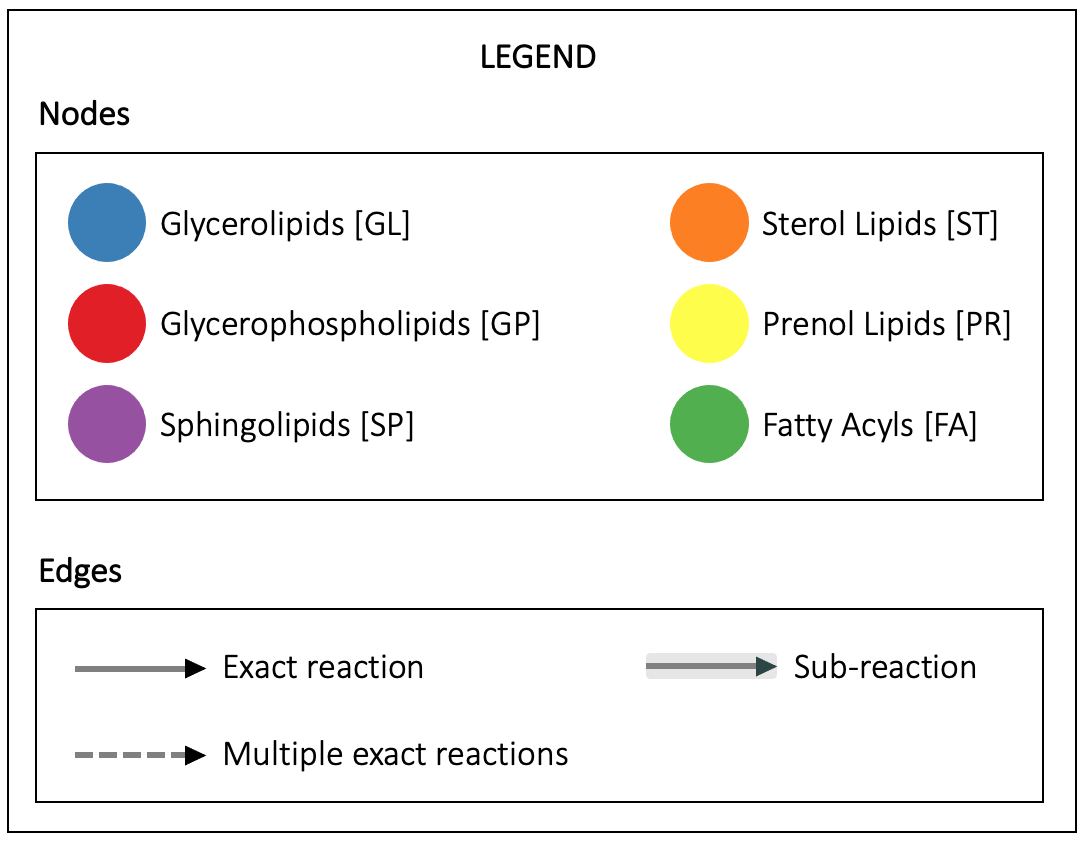Structure Database (LMSD)
Common Name
MGDG(16:0/16:1(9Z))
Systematic Name
1-hexadecanoyl-2-(9Z-hexadecenoyl)-3-O-β-D-galactosyl-sn-glycerol
Synonyms
- Monogalactosyldiacylglycerol(16:0/16:1)
3D model of MGDG(16:0/16:1(9Z))
Please note: Where there are chiral atoms but the stereochemistry is undefined, the 3D model takes an arbitrary conformation
Classification
Category
Main Class
Sub Class
Reactions
Filter by species:
ⓘ
Reactions are shown if the E.C. number of the enzyme catalysing it is annotated in the UniProt database for a species belonging to the selected taxonomic class.
Click on an edge to display the reaction(s).

References
Taxonomy Information
Curated from
NCBI taxonomy class
Reference
Sargassum horneri
(#74089)
Phaeophyceae
(#2870)
Isolation of the molecular species of monogalactosyldiacylglycerols from brown edible seaweed Sargassum horneri and their inhibitory effects on triglyceride accumulation in 3T3-L1 adipocytes.,
J Agric Food Chem, 2014
J Agric Food Chem, 2014
Pubmed ID:
25363514
DOI:
10.1021/jf503068n
String Representations
InChiKey (Click to copy)
SEERXXKFFSXYGE-MGUCWTJLSA-N
InChi (Click to copy)
InChI=1S/C41H76O10/c1-3-5-7-9-11-13-15-17-19-21-23-25-27-29-36(43)48-32-34(33-49-41-40(47)39(46)38(45)35(31-42)51-41)50-37(44)30-28-26-24-22-20-18-16-14-12-10-8-6-4-2/h14,16,34-35,38-42,45-47H,3-13,15,17-33H2,1-2H3/b16-14-/t34-,35-,38+,39+,40-,41-/m1/s1
SMILES (Click to copy)
O([C@H]1[C@H](O)[C@@H](O)[C@@H](O)[C@@H](CO)O1)C[C@@](OC(CCCCCCC/C=C\CCCCCC)=O)([H])COC(CCCCCCCCCCCCCCC)=O
Other Databases
Calculated Physicochemical Properties
Heavy Atoms
51
Rings
1
Aromatic Rings
0
Rotatable Bonds
36
Van der Waals Molecular Volume
785.48
Topological Polar Surface Area
154.05
Hydrogen Bond Donors
4
Hydrogen Bond Acceptors
10
logP
10.57
Molar Refractivity
205.63
Admin
Created at
14th Aug 2020
Updated at
25th Apr 2022
LIPID MAPS® abbreviations for glycerolipids (GL)
The LIPID MAPS® glycerolipid abbreviations (MG,DG,TG) are used here to refer to species with one, two or three radyl side-chains, respectively, where the structures of the side chains are indicated within parentheses in the 'Prefix(sn1/sn2/sn3)' format (e.g. TG(16:0/18:1(9Z)/18:0). Acyl chains are assumed by default. The alkyl ether linkage is represented by the 'O-' prefix, e.g. DG(O-16:0/18:1(9Z)/0:0), whereas the 1Z-alkenyl ether (Plasmalogen) linkage is represented by the 'P-' prefix, e.g. and DG(P-14:0/18:1(9Z)/0:0).
For Diradylglycerols and Triradylglycerols, it is not always possible to experimentally determine the exact position of radyl groups on the glycerol group. For Diradylglycerols with two different radyl groups, two different structural isomers exist. For Triradylglycerols with three different radyl groups, six different isomers exist.
Instead of drawing all possible structural isomers explicitly for Diradylglycerols and Triradylglycerols, the LIPID MAPS® abbreviation scheme supports the isomeric specification. A suffix containing 'iso' along with the number of possible isomers is appended to the abbreviation (e.g. [iso2],[iso6]) and a single unique LM_ID is assigned. The structure assigned to the LM_ID corresponds to the radyl substitution shown in the abbreviation. An option is provided to display the other isomers in the group.
The [rac] designation refers to racemic mixtures due to substitution at the sn1 and sn3 positions of glycerol.
The LIPID MAPS® glycerolipid abbreviations (MG,DG,TG) are used here to refer to species with one, two or three radyl side-chains, respectively, where the structures of the side chains are indicated within parentheses in the 'Prefix(sn1/sn2/sn3)' format (e.g. TG(16:0/18:1(9Z)/18:0). Acyl chains are assumed by default. The alkyl ether linkage is represented by the 'O-' prefix, e.g. DG(O-16:0/18:1(9Z)/0:0), whereas the 1Z-alkenyl ether (Plasmalogen) linkage is represented by the 'P-' prefix, e.g. and DG(P-14:0/18:1(9Z)/0:0).
For Diradylglycerols and Triradylglycerols, it is not always possible to experimentally determine the exact position of radyl groups on the glycerol group. For Diradylglycerols with two different radyl groups, two different structural isomers exist. For Triradylglycerols with three different radyl groups, six different isomers exist.
Instead of drawing all possible structural isomers explicitly for Diradylglycerols and Triradylglycerols, the LIPID MAPS® abbreviation scheme supports the isomeric specification. A suffix containing 'iso' along with the number of possible isomers is appended to the abbreviation (e.g. [iso2],[iso6]) and a single unique LM_ID is assigned. The structure assigned to the LM_ID corresponds to the radyl substitution shown in the abbreviation. An option is provided to display the other isomers in the group.
The [rac] designation refers to racemic mixtures due to substitution at the sn1 and sn3 positions of glycerol.